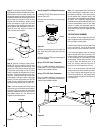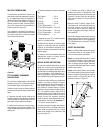
NOTE: DIAGRAMS & ILLUSTRATIONS NOT TO SCALE.
10
Locking Band
Mastic
Figure 30
Step 9. Security Chimneys locking bands,
Model FLB, may be required if the chimney
extends too high above the roof flashing. As a
general rule, if the chimney extends more than
6' above the roof flashing, the use of locking
bands is advisable to strengthen the chimney
assembly. Align the locking band at the chim-
ney joint. Locking bands wrap around pipe
joints equally covering the joints of both pipe
sections. Use the nut provided and TIGHTEN
snugly. Do not overtighten as this might dam-
age the chimney section (
refer to Figure 30
).
Note: If chimney extends more than 8' above
roof surface, guy wires are also recommended.
Use three (3) guy wires, attach to locking band
assembly, extend and secure to roof in a trian-
gular pattern (Figure 31 ). Guy wires are not
supplied by the manufacturer.
Roof Ridge
120°
CTD
Termination
Chimney
Step 10. Using a FTF13-CTD Round Termination:
1. Hold the FTF13-CTD over top of last chimney
section (
Figure 32
).
2. Center inner slip section in inner flue pipe-
slip down.
Step 8. The standard Security Chimneys F10
roof flashing assemblies include a storm collar.
Slide the storm collar over outer chimney, rest
on flashing spacers and align with top surface
of flashing. Insert tab in slot, pull tight and bend
tab back over slot. Seal storm collar to outer
chimney with roof caulking or mastic around
entire circumference of pipe. Also add extra
roof caulking to the tab/slot area to seal com-
pletely against water penetration (
Figure 30
).
Check all joints very carefully to ensure no
water intrusion can take place.
Figure 32
3. Center outer locking section over outer flue
pipe. Push down until locking tabs are firmly
engaged.
4. Pull up slightly on CTD to ensure locking joint
has firmly engaged.
Using a FTF13-CT1 Chase Termination:
Refer to specific installation instructions in-
cluded with FTF13-CT1 chase terminations for
clearance and installation details.
Using a FTF13-CT2 Chase Termination:
Refer to specific installation instructions in-
cluded with FTF13-CT2 chase terminations for
clearance and installation details.
Figure 31
Note: It is recommended that all exterior ex-
posed metal fireplace components; such as
terminations, flashings, storm collars and/or
flue be painted with a premium quality, high
temperature, rust preventative paint designed
for metal. This is especially important when
installations are made in abnormally adverse or
corrosive environments; such as near lakes,
oceans or in areas with consistently high hu-
midity conditions. Consult the paint manufac-
turers instructions for proper preparation and
application.
TEN FOOT RULE SUMMARY
The minimum chimney height above the roof
and/or to adjacent walls and buildings is speci-
fied by all major building codes.
If the horizontal distance from the peak of the
roof is less then 10', the top of the chimney
must be at least 2' above the peak of the roof.
If the horizontal distance from the chimney
edge to the peak of the roof is more than 10' a
chimney height reference point is established
on the roof surface 10' horizontally from the
chimney edge. The top of the chimney must be
at least 2' above this reference point. In all
cases, the chimney cannot be less then 3'
above the roof at the edge of the chimney.
The 2' in 10' rule is necessary in the interest of
safety but does not ensure smoke-free opera-
tion. Trees, buildings, adjoining roof lines, ad-
verse wind conditions, etc., may require a taller
chimney should the fireplace not draft properly
(
see Figure 33
).
Figure 33
Less Than 10'
3'
Min
2' Min.
10'
3'
Min


















